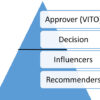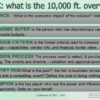As a Business Development Representative (BDR), understanding and meeting activity metrics is crucial. However, to truly excel and maximize your success, you must also focus on key time management metrics. These metrics are leading indicators that, when managed well, can significantly enhance your effectiveness and efficiency in your daily job. Let’s explore these essential time management metrics and how they can lead to your success.
The Flow from Activity Metrics to Time Management
In a previous post, I discussed critical activity metrics such as calls per day, emails per day, and meetings scheduled per week. These activity metrics are the foundation of your daily tasks, helping you build and maintain a robust sales pipeline. Now, let’s dive into time management metrics, which will help you optimize your follow-ups and initial contacts, ensuring you capitalize on every lead generated from your activities.
1. Meetings Scheduled per Week
- Benchmark: 5-10 meetings
- Details: The number of meetings or demos scheduled with potential clients each week. This is a critical metric for progressing leads through the pipeline.
- Contextual Variations:
- Lead Quality: High-quality leads may convert to meetings more frequently.
- Industry: Certain industries may require more touchpoints before scheduling meetings.
2. Conversion Metrics
Lead Conversion Rate
- Benchmark: 15-25%
- Details: The percentage of leads that convert to qualified opportunities. Indicates the effectiveness of the BDR’s qualification process.
- Contextual Variations:
- Lead Source: Leads from inbound marketing may have higher conversion rates.
- Qualification Criteria: Strict criteria might lower conversion rates but improve lead quality.
Opportunity Conversion Rate
- Benchmark: 20-30%
- Details: The percentage of qualified opportunities that progress to the next sales stage. Reflects the quality of leads and the effectiveness of the sales handoff.
- Contextual Variations:
- Sales Handoff Process: Smooth transitions can improve conversion rates.
- Sales Rep Performance: Strong sales reps can boost conversion rates.
3. Time Management
Average Time to First Contact
- Benchmark: 24-48 hours
- Details: The time it takes for a BDR to make initial contact with a new lead. Quick responses can improve engagement rates.
- Contextual Variations:
- Lead Source: Hot leads often require quicker follow-ups than cold leads.
- Time Zone Differences: Global leads might affect response times.
The time it takes to make the first contact with a new lead is crucial. A prompt response can significantly increase the likelihood of engaging the prospect. Hot leads, in particular, should be contacted within 24-48 hours to capitalize on their initial interest. Industry benchmarks suggest that around 80% of hot leads should be valid and responsive, indicating a high probability of conversion if contacted promptly.
Average Follow-Up Time
- Benchmark: 2-3 days
- Details: The average time it takes to follow up after initial contact. Regular follow-ups show persistence and improve conversion rates.
- Contextual Variations:
- Lead Engagement: More engaged leads might warrant quicker follow-ups.
- Sales Cycle Length: Shorter cycles might require faster follow-ups.
Following up promptly after initial contact is essential to keep the prospect engaged. A benchmark of 2-3 days ensures that leads are not left waiting too long, which can result in lost interest or missed opportunities.
Enhancing Your Metrics: Practical Tips
- Improving Time to First Contact:
- Prioritize Hot Leads: Set up alerts for new hot leads to ensure they are contacted promptly.
- Automate Initial Outreach: Use automation tools to send an immediate response, acknowledging the lead and setting up a time for a follow-up call.
- Optimizing Follow-Up Time:
- Create a Follow-Up Schedule: Use your CRM to schedule and track follow-ups, ensuring no lead is left unattended.
- Tailor Follow-Up Content: Customize follow-up messages based on previous interactions and the prospect’s specific interests or pain points.
- Balancing Activity and Time Management:
- Allocate Time Blocks: Dedicate specific times of the day for different activities, such as calling, emailing, and follow-ups.
- Use CRM Analytics: Leverage CRM analytics to identify the best times to contact leads and adjust your schedule accordingly.
Why It Matters
Exceeding benchmarks is not just about meeting minimum standards; it’s about striving for excellence and setting yourself apart in a competitive market. Consistently surpassing these metrics will:
- Increase Your Effectiveness: Higher engagement and conversion rates mean more qualified leads and opportunities.
- Build a Stronger Pipeline: By maintaining high activity levels and effective time management, you’ll ensure a steady flow of prospects through your sales funnel.
- Enhance Your Reputation: Demonstrating a commitment to exceeding benchmarks shows dedication and competence, which can enhance your reputation within your organization and industry.
Mastering time management metrics is as crucial as hitting activity metrics for BDRs. By focusing on quick initial contacts and timely follow-ups, you can enhance your engagement rates and convert more leads into opportunities. These time management practices, when combined with consistent activity efforts, will significantly increase your chances of success in the competitive world of sales.
Treat these metrics as leading indicators of your success. By optimizing both your activity and time management, you’ll be well on your way to achieving and surpassing your sales goals.
By incorporating these best practices into your daily routine, you’ll not only manage your time more effectively but also ensure that your efforts lead to meaningful engagements and conversions. This balanced approach will help you maintain a robust pipeline and drive sustained sales success.














